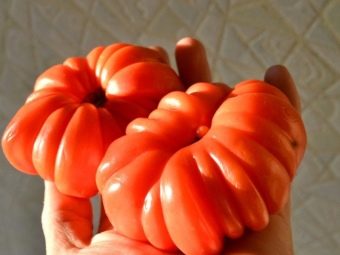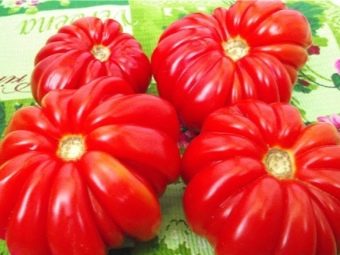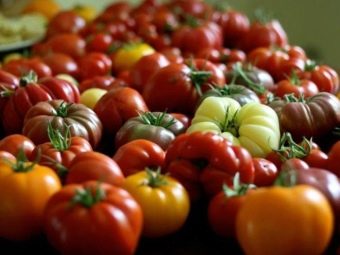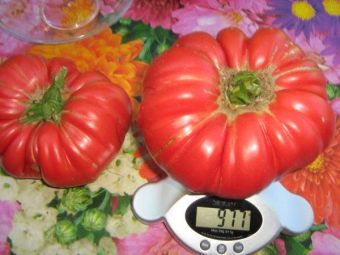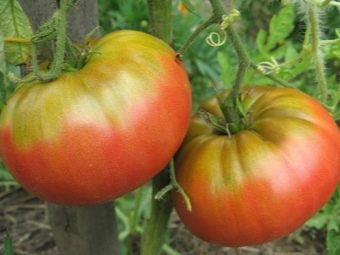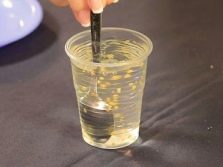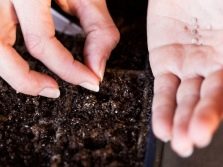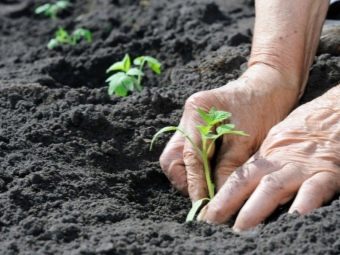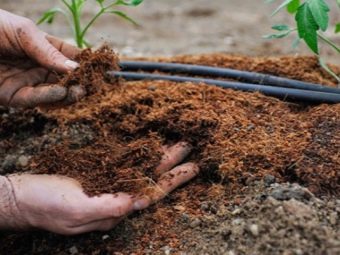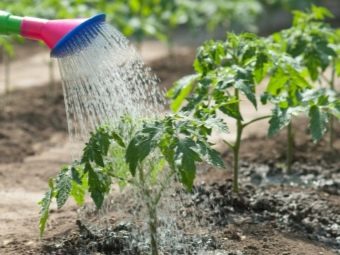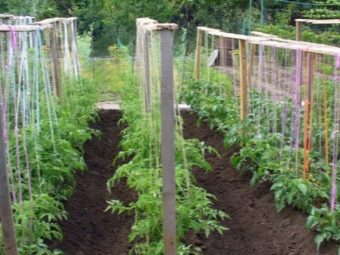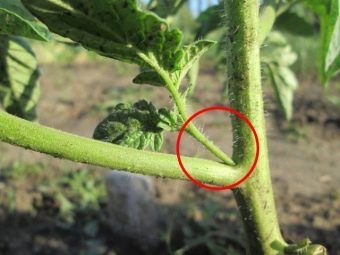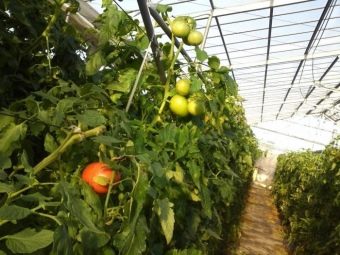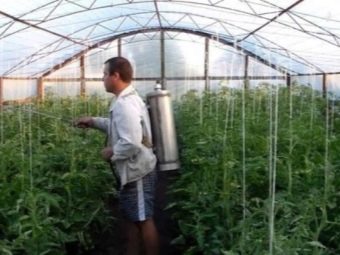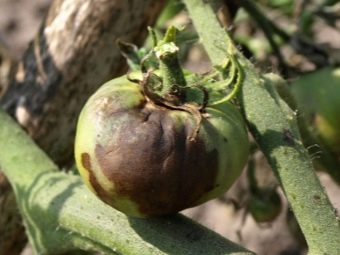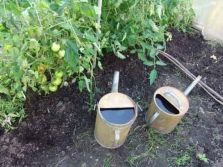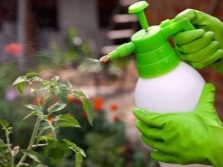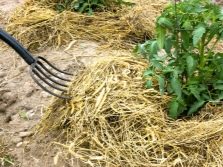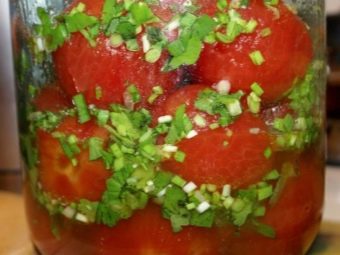Features of a grade of tomatoes "Japanese crab"
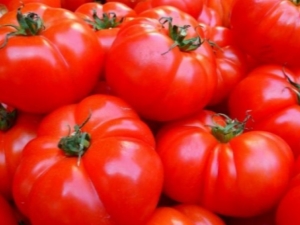
Italians call a tomato "golden apple".The French called him “the apple of love,” and the Germans called the “paradise apple.” "Japanese Crab" - a variety of tomatoes received such an unusual name, having no relation either to the crustacean family or to distant and beautiful Japan. He was given this name for a claw-shaped vegetable.
For their taste, the Japanese Crab has become very popular. He really deserved a decent place on our tables. The tomato has a delicious taste. This cultivar of tomato when cultivating requires special attention, therefore, before planting a “Japanese Crab” on its plot, it is necessary to learn more about its agrotechnical requirements.
Description of the variety
A variety is not a hybrid, that is, at the genetic level, its seeds store all information about growing conditions. It is better adapted to the surprises of nature than hybrid varieties. Seeds collected from ripe fruits, the next year give a wonderful harvest. The variety is resistant to all sorts of diseases that are common among the nightshade family. "Japanese crab" is subject only to fungal diseases. Tomato bushes grow with medium-sized light green leaves. Under favorable conditions, the plant reaches a two-meter growth. Each bush forms up to 6 brushes.
The tomato contains a lot of fiber, it contains vitamins A and C. Tomatoes have pigment lycopene, which manifests itself as the best antioxidant that provides prevention of cancer and diseases of the cardiovascular system.
Features of the fruit
Tomato has a very interesting bright taste and aroma. A feature of the variety is that the fruits do not have specific sizes. The size of the fetus can be completely different. It depends on various factors: on the region of growth, on weather conditions, prolonged spring cold, on the period of planting and other things. "Japanese crab" has a flat and rounded shape. Next to the stalk is a dark spot, which is a characteristic feature of the variety.
Mature fruits are very diverse in color. They can be of different colors: pinkish crimson, red or even yellow. The fruits are not very dense, but juicy and fleshy. A characteristic feature of the “Japanese Crab” fruit is a ribbed claw-like form of the stem. Ripe fruits of tomato reach a weight of more than 300 grams. With good weather conditions and good care, they can weigh up to one kilogram.
The fruit never cracks because it has a dense protective skin that preserves the integrity of even the largest fruits.
Characteristic
"Japanese crab" refers to high-yielding varieties. For the correct and caring care, a plant with one square meter of infield can thank you 14 kg of tomatoes.
According to reviews of gardeners, "Japanese Crab" surpasses many other varieties of tomatoes in its taste. Tomato has a good seed germination - it is more than 95%. Siberian agronomists created the variety "Japanese Crab" for its harsh conditions.
Justifying the expectations of gardeners, he perfectly adapts to the various climatic conditions of our vast country. However, this variety should not be cultivated in the southern regions. He is not adapted to the hot climate and will not be able to thank the host for a good harvest. "Japanese crab" is adapted to the harsh climate and therefore grows very well in regions with a rather cold climate.
To get a good harvest, you should carefully follow the rules for preparing, planting seeds and caring for seedlings. The variety is capricious and requires a lot of attention. He has a poor adaptability to storage. The ovaries and flowers are very tender and can fall off under adverse conditions, especially at low temperatures (below +4 degrees).
Growing seedlings
"Japanese crab" requires special care from the very first days of cultivation.Seeds before planting should be held for a couple of days in a non-concentrated solution of potassium permanganate, and then rinsed well. Seeds for seedlings are best planted in mid-March. Sowing depth - no more than 1 cm. It should be noted that regular watering is required before the first shoots. When growing seedlings, it is necessary to create suitable growth conditions for small boreholes. It is necessary to provide them with the necessary lighting, feeding and create the desired temperature.
Picks should be made after the plant has fully formed two leaves. "Japanese Crab" loves loamy soil.
Landing in the ground
At the time of planting tomatoes in the soil on the plant should be formed of at least six full leaves. It is desirable that the height of the stem reaches 20 cm. Landing in the ground, depending on the region should be made from mid-April to mid-May. To protect against spring frosts, you must create a shelter of film or agrofibre.
"Japanese crab" loves space. On one square meter you can plant no more than 4 bushes. Saplings are placed in a staggered or double row arrangement. This variety loves the soil on which they grew cabbage, various legumes, carrots, cucumbers or onions last year. But after such predecessors as eggplant, potatoes or peppers, it is not necessary to plant tomatoes.
Before planting seedlings in a greenhouse, you need to prepare for 2 weeks and make the necessary fertilizers. Fresh manure is not recommended, because it promotes the growth of leaves, because of which the formation of the ovary is slowed down.
Before planting seedlings in open ground, the soil should be prepared in autumn. It is necessary to dig up a land plot with a depth of immersion on a spade bayonet with simultaneous application of organic fertilizers (compost, manure).
Care
Caring for plants is the same as for other varieties of tomatoes. It consists in constant watering, regular loosening and weeding from weeds. Tomatoes of this variety are very demanding for watering. It must be carried out in the hole at the very root early in the morning or in the evening, when it is cool and there is no direct sunlight. Due to the severity of the fruit bushes should be tied up. For this purpose, it is worthwhile to build vertical and horizontal trellis to help save space on your backyard. Without tying bushes can break.
The vertical arrangement of the bushes will allow the plants to get the right amount of sunlight.
Experienced gardeners practicing pasture making on one or maximum two stalks. The second stem grows from the first stepson, which is located directly above the ground. When removing the remaining stepsons, it is necessary to leave small hemp, which will not allow a new shoot to grow. "Japanese crab" grows like a vine, and in order to get more nutrients and moisture to the plant itself, it is necessary to remove excess leaves.
It is recommended to pinch the main stem a month before the end of fruiting, it is necessary to speed up the process of fruit ripening. The very first crop from tomatoes can be obtained in late July-early August. In tomatoes, the process of fruiting in the open ground can last until the onset of cold autumn. When grown in a greenhouse, tomatoes have good yields until frost until about November. This variety is very well adapted to industrial greenhouses, in which it bears fruit almost all year round.
Pests and diseases
To obtain a good harvest it is necessary to carry out preventive work against insects. Every two weeks should be treated with insecticides and fungicides bushes. Practiced neighborhood with plant crops that scare pests. The variety is susceptible to fungal diseases, so tomatoes can not be watered on top of the plant, but only under a bush. "Japanese crab" is ill with phytophtora and cladosporia.When grown in a greenhouse, it is necessary to maintain the required level of humidity and optimum temperature conditions.
To prevent the occurrence of blight fungi, the seedlings are sprayed with kefir, Bordeaux mixture, blue vitriol. With the disease on the surface of the fruit spots appear brown, with a whitish coating. With late blight, ash treatment is carried out every three days. When cladosporia such spots appear on the leaves. From this disease, you can get rid of drugs with a high concentration of copper, such as phytosporin.
Fertilizer
For better fruiting tomatoes "Japanese crab" the soil should be fertilized. Stimulants can be made no more than four times per season, otherwise the leaves will begin to actively and quickly develop and grow. Taking many nutrients from the plant, they will not allow to get the required amount of ovary on the bushes. When feeding with complex fertilizers, one should observe balance and take into account the weather conditions. In the heat of the tomatoes need a lot of nitrogen.
In cloudy weather, potassium is needed due to a lack of active sunlight. During the ripening of fruits, it is necessary to abandon artificial fertilizers. To preserve the beneficial moisture will mulching.
Rows with tomatoes should be covered with mowed grass, sawdust or paper, which during the season rot and fertilizes the soil well.
What to do with the harvest?
"Japanese Crab" - a very tasty and popular variety of tomatoes, which is suitable for cooking salads. An interesting fact - due to the large content of serotonin in tomatoes, they elevate mood better than chocolate. The fruit skin is very delicate and uniform. It is invisible by eating fresh vegetables. The fruits have dense pulp and they contain a small amount of seeds. This property of tomato is used to give a beautiful look to culinary dishes. From the Japanese Crab tomato you get wonderful winter preparations.
If you responsibly approach the cultivation of tomatoes and follow all the rules of plant care, you can get a wonderful crop that diversifies your table with all sorts of salads and snacks in the summer and preservation in the winter. All winter you will be able to feast on lecho and tomato juice.
About what are the secrets to increase urazhaya tomato, see the following video.

